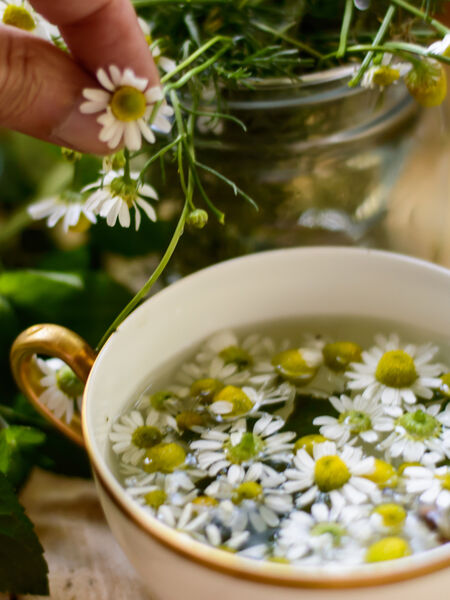All About Calming Herbal Brews Part 1

Have your customers asked for suggestions for teas that relax, help with sleep or soothe anxiety? The answer may already be on your shelves: herbal teas.
Tisanes or herbal teas are elixirs of flavor with the added health benefits of vitamins, minerals, anti-inflammatories, and lack of caffeine. It's no wonder they’ve been used for centuries as both beverages and medicine.
Beverages from plants, flowers, or trees are known as tisanes or herbal “teas” because a tea is a beverage using a plant part with boiling water to produce a beverage. These may include flower petals, roots or leaves; tree bark or leaves; plant roots or leaves, and herbs. However, Camellia sinensis is the only plant that is a “true tea” beverage which is processed as puerh, black, oolong, yellow, green or white tea.
To brew most herbal teas, use fresh, clean water heated to boiling, 212° F., and steep for least 5 minutes or longer to taste. For iced versions, brew as usual and chill before serving. Most take well to sweetening, especially honey or rock sugar, and many herbals mix well with others. When brewing tisanes in-store, don’t be surprised that the intoxicating aromas will draw nearly everyone to your brewing station. Keep a plain white bowl of the herbals to show off their color and forms, make suggestions for sweeteners, and emphasize that it is nearly impossible to brew an herbal too long.
There are hundreds, perhaps thousands, of plant parts that make fantastic beverages. We offer several to consider for your inventory.
Lavender and Chamomile each offer a hot, soothing tonic to assure a good night’s sleep. Chamomile flowers, golden yellow and white, produce a silky liquid that provides a luxurious mouth feel and its delicate taste adds to the pure relaxation you’ll feel when sipping it just before bedtime. Made from flowers from the Nile River Valley in Egypt, and considered a remedy for all ailments by the ancient Egyptians, this golden herb remains a modern favorite to promote calm and relieve anxiety. When steeped, these fragrant chamomile blossoms smell of freshly cut apples and produce a rich, golden cup with calming flavor and a sweet, floral finish. Our Chamomile tea is made with whole flower pieces and produces a delicious, caffeine-free infusion. It may also be served with a dash of honey.
Flower petals from the elegant lavender stalks, well known for its beautiful pale purple color and sweet fragrance, make a tea that provides the body with a gentle calm and deliciously tasty brew that is sure to bring pleasant dreams at night or reduce anxiety or stress during the day. Both chamomile and lavender are kind to the digestive system and are natural anti-inflammatories. Legend has it that lavender farmers take breaks after just a few hours of harvesting because the aroma causes drowsiness!
Lemon Balm (Melissa officinalis), also known as blue, sweet or garden balm or the honey plant, is a member of the extensive family of mint. A native to Europe, but now grown world-wide, lemon balm is a must for any garden as it attracts bees. A calmative, it has for centuries been used to reduce stress and anxiety, promote good digestion and healthful sleep, and is a delightful herb to use in cooking. Its flavor is mildly lemon, like citronella, and is excellent in desserts, true tea blends, or blends with other herbals. The plant has small, light yellow flowers that grow near the leaves which are the source of what makes up this herbal brew. The tart-sweet fragrance of lemons is apparent in the fresh leaves and only slightly milder when dried. Medically, it acts as an antibacterial/antiviral because of its natural chemical elements of eugenol, tannin, and terpenes. Just a half teaspoon can easily flavor a green or black tea or herbal tea of your choice.Check out our Daydream herbal blend that includes Lemon Balm for its calming properties.
Lemon Balm and Lavender are not only delicious by themselves. When combined they’re extraordinary and open up plenty of possibilities for exploration to devise your own proprietary recipe. Also, cooking with these herbals or using them to garnish dishes from rice or couscous or in salads provide plenty of incentive to experiment.
Peppermint is the go-to herbal brew for delicious minty flavor and, as necessary, is an excellent tea for after heavy meals, for mild digestive concerns, and, of course, has no caffeine making it a delicious alternative for nighttime beverages. This Mediterranean native cools the body because of the leaves’ natural menthol, provides a crispy tingling aroma, and a totally refreshing flavor and a soft mouth feel finish.
While it’s true that chocolate has caffeine that could interfere with sleep for some people, if you long for a nibble of something dark and sweet, a chocolate truffle eaten along with sips of peppermint tea will bring you as close to nirvana as possible!
Remember that a little peppermint goes a long way but elevates a traditional black iced tea, perfumes chocolate desserts, and adds a unique twist to a vinaigrette. Remind your customers that part of the fun of herbals is to experiment!
PRECAUTIONS: All the herbals listed described above are healthful for most adults, however, if you are pregnant or intend to be, or if you have any chronic disease for which you take medicines, please consult with your physician before consuming herbal teas. This is particularly critical if you take sleeping pills or prescribed drugs for thyroid disease, diabetes, or heart disease because interactions may occur. Even when given the okay, keep consumption to one or two small cups per day as excessive consumption can cause headaches, constipation, or dizziness in some people.

